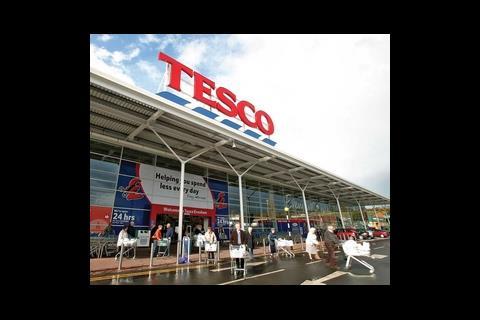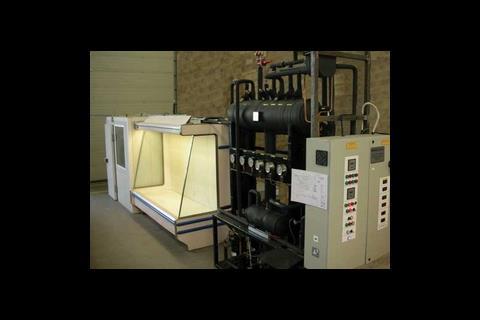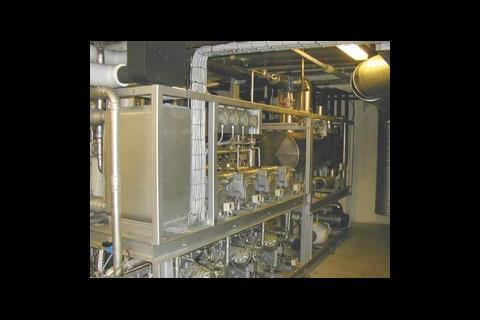Supermarket chiller cabinets emit hundreds of tonnes of CO2 a year. Yet new refrigeration systems that run on CO2 could cut this significantly. Tesco’s head of refrigeration Andy Campbell explains.
The next time you’re buying your weekly groceries and weighing up the food miles between the Kenyan mangetout and the runner beans from Kent, spare a thought for the global warming potential of the store itself.
Supermarkets consume an incredible 15,000GWh or 54,000 tera joules of electricity a year. About 40% of this powers refrigeration systems for display and storage of food.
But it is not just the energy they burn that needs to be considered. Refrigeration systems can have a far bigger impact on the environment through leaking refrigerants, many of which have global warming potentials (GWPs) in excess of 1000.
Over the past 20 years, legislation has prohibited the use of many ozone-depleting refrigerants including CFCs and HCFCs. However, use of HFC refrigerants is still legal and commonplace.
In recent years natural refrigerants have been proposed as an environmentally friendly alternative. These include ammonia, hydrocarbons and carbon dioxide (CO2). They do not contribute to ozone depletion and have low global warming potentials. Among these, CO2, or R-744 as it’s known, offers a long-term solution for many applications.
R-744 has a number of advantages over other natural refrigerants. To start with it has a high volumetric refrigeration capacity, as a result of its high vapour density. This means compressors using it are between six and eight times smaller, in displacement terms, than those of R22 systems.
Further benefits of high vapour density are realised when applied to pipework and valves, which can be reduced in size and gauge.
CO2 also has improved heat transfer properties. This allows the evaporator to operate at a higher temperature than an R404a equivalent. In fact evaporators may work at least 2ºC higher than conventional R404a evaporators and these improved heat transfer properties result in increased capacity in standard heat exchangers.
The main characteristics of R-744 as a refrigerant are that the critical (superheated vapour) and triple points (where it can exist as a solid, liquid and gas) are relatively low at 31ºC (73 bar) and -56.6ºC (5.2 bar) respectively (see figure 1 overleaf). In order to remain below the critical temperature of 31ºC it is necessary to use a cascade system to provide a heat sink to allow the CO2 to condense.
Application of R-744 in supermarkets It’s the environmental properties associated with R-744 that make it so attractive for supermarket applications. Its non-toxic and non-flammable nature is particularly important given that the refrigerant pipework runs through the customer area.
Over the years a number of systems have been installed and tested using a central ammonia/ hydrocarbon chiller and a secondary distribution system using Tyfoxit, propylene glycol and other heat transfer fluids. The disadvantages of these fluids are that although they are safe, non-toxic and non-flammable, they are expensive, have high viscosity, low heat transfer and poor thermophysical properties. They also introduce practical complications through corrosion and material compatibility.
However, the use of CO2 with a hydrocarbon or ammonia primary chiller presents the opportunity to refrigerate retail food areas with a refrigerant that is low carbon, safe and has a low GWP. The latter is important because of the potential refrigerant leakage rates characteristic of the complexity and size of these systems.
This is highlighted in figure 2, which shows a typical cascade CO2 system for a supermarket. The system consists of medium temperature sections serving chilled food cabinets and low-temperature sections serving the frozen food cabinets.
The pressure-enthalpy chart in figure 3 shows the cascade sub-critical cycle using a primary refrigerant with a cascade CO2 system. A number of these systems have now been tested and it is reported that energy savings of 11%-15% have been achieved compared with a typical R-404a reference cycle.
In terms of carbon, the savings are potentially even greater because direct emissions will be several orders of magnitude lower due to the low GWP of the natural refrigerants.
Alternatively, CO2 has been used in a trans-critical cycle in retail applications. A number of systems have been developed; a conceptual schematic for one is shown in figure 4 and its pressure-enthalpy chart is shown in figure 5.
It can be seen that the high pressure condition is above the critical point and heat rejection occurs without change of phase in the gas cooler. One key advantage of this cycle is the availability of high temperature energy at the compressor discharge, which offers potential for high grade heat recovery.
A further advantage is the system’s simplicity, with a single refrigerant and compression cycle. However, the intermediate gas is returned to the compressor suction and this re-expansion at low pressure presents an avoidable and significant reduction in co-efficient of performance (COP).
Pilot commercial system In the past the R-744 systems proposed and installed have been industrial in nature and their higher specification means the capital cost is higher than conventional R-404a systems – about 20% higher according to some estimates.
To combat this, work has been carried out to develop a commercial CO2 system that is more economic, but retains the safety and integrity features.
Tesco and London South Bank University carried out work on a pilot system. This was designed as a dual temperature cascade arrangement with refrigerant R-404a as the heat rejecting/condensing medium for the R-744 two-stage cycle.
This arrangement enables the R-404a system to be a small compact unit, with minimal charge and leakage risk. The R-404a cycle evaporates at -15ºC and condenses at 36ºC and uses two scroll compressors. The evaporator is a plate heat exchanger, which acts as the condenser for the R-744 cycle. It condenses the discharge gas from the R-744 compressor, serving the low temperature system and the flash gas from the wet suction on the high temperature R-744 evaporator.
The R-404a evaporator was sized to remove the heat from both the low temperature and high temperature R-744 cooling systems. At the high temperature condition the R-744 is condensed and held in the pulse vessel, which acts as the liquid receiver and separation vessel. The high temperature R-744 evaporator is fed from the pulse vessel via a refrigerant pump, which feeds the refrigerant at a 4:1 circulation ratio.
The R-744 at -10ºC acts as a volatile secondary refrigerant in respect to sensible and latent cooling, making the evaporator more efficient. The refrigerant returns to the pulse vessel from the evaporator as a saturated liquid via the wet suction, where it is re-condensed.
The flash gas leaves the vessel and enters the condenser to liquefy and then return to the vessel at -10ºC. The low temperature liquid R-744 also leaves the pulse vessel at -10ºC and feeds its evaporator where it is expanded to boil at -28ºC, returning via the dry suction to the R-744 compressor, thus completing the cycle. See figure 5, right.
Performance of the pilot commercial system
The performance of the pilot system was calculated and then measured using a test rig (see table 1 below).
There was reasonable agreement between design and measured performance. Discrepancy between the two is largely due to transient measurement conditions and manufacturers’ tolerances. The calculated comparative COP for a similar R-404a system was below 1 and the relative improvement in performance of the CO2 system is similar to that reported in other studies.
Case studies
To try and reduce the carbon footprint of its stores, Tesco commissioned a number of CO2 refrigeration installations.
One of these was in Llansamlet, Swansea. This comprised 5574m2 of nett retail space, with 354kW of chilled food cabinets and 57kW of frozen food cabinets. The systems consisted of one sub-critical system serving 19.5m (14.98kW) of frozen food cabinets and one trans-critical system serving 22.5m (38.5kW) of dairy and chilled produce food cabinets.
The aim of installing the two systems was to test their operational and energy performance in a live application, with a view to making a generic corporate system specification for future stores.
The sub-critical system (figure 6) was chosen specifically as an energy efficient and low carbon alternative to a conventional R-404a single stage system, while the trans-critical system (figure 7) was chosen as a low carbon alternative to a HFC system. Although trans-critical systems are normally designed to operate more efficiently with a heat reclaim facility, this system was installed without this, primarily to avoid the additional complexity associated with the control of heating and cooling output. This feature and its impact are subject to further study.
Consequently, from an energy perspective the trans-critical system may be optimised for significant performance improvements. In addition the store also had four R-404a (two high temperature, two low temperature) single-stage systems serving the remainder of the chilled and frozen food.
How did they perform?
After a year of operation the performance of the systems was compared against a like-for-like HFC system installed as a control. As can be seen in figure 8, the R-744 cascade low temperature system shows a better COP compared with the HFC control.
Observation from site showed this to be partly due to the reduced temperature lift, associated with the improved heat transfer within the R-744 heat exchanger, and also reduced system pressure drop.
It was also observed that on start-up the increased heat transfer resulted in ice build-up on the food on the CO2 cabinets only. This was rectified by raising the evaporation temperature, which consequently raised the COP.
The data taken from the trans-critical system needed further clarification and cannot be reported at this point.
Other observations related to the operational characteristics associated with the systems. The compressors selected for the trans-critical system used two-pole motors, which were particularly noisy, however subsequent versions have remedied this.
Also, standard in-store maintenance procedures have been successfully followed with all systems. In particular, the in-store cleaning of CO2 cabinets using hot water at 60ºC was successfully achieved because all shut-off valves had been eliminated within the cabinet vicinity, allowing safe expansion of the CO2 back to the compressors.
Overall the installation was simply and efficiently executed within normal Tesco construction time frames. Capital was greater for both systems, but Tesco expects that in the long term economies of scale will mean there will be no significant difference in system cost between R-744 and R-404a technology.
In order to evaluate the potential carbon saving associated with direct and indirect emissions, performance was assessed based on a system installed in a Tesco store in Shrewsbury. This comprised 342kW of high temperature and 69kW low temperature load, met with two cascade systems using
R-1270 as the primary refrigerant and R-744 as both the low temperature DX refrigerant and the high temperature secondary volatile refrigerant. This store is the largest supermarket natural refrigerant application installed in the UK to date.
In order to justify this system, a total equivalent warming impact (Tewi) investigation was carried out to compare the systems with a standard reference using typical industry performance parameters. The results of this investigation (see table 2 below) show the significant carbon reduction associated with the R-744 scheme, which is due primarily to the avoidance of HFC emissions with a high global warming potential factor of 3750.
The potential for transcritical systems has not as yet been fully explored using monitored data. Also there is considerable potential for use of high-grade waste heat to drive an integrated sorption cooling system and other heat demand applications.
A hybrid system using either series compressors or intermediate feed would produce better COP for transcritical applications comprising DX low temperature and flooded high temperature as can be seen from figure 9.
Further work and modelling will be carried out using this system and the research will include investigations into using the rejected heat to provide heating and cooling for the store using LTHW and sorption cooling.
Downloads
Figure 1: Simplified pressure-enthalpy diagram for CO2
Other, Size 0 kbFigure 2: Typical cascade refrigeration system using R1270/R-744
Other, Size 0 kbFigure 3: Pressure-enthalpy chart for a cascade refrigeration system
Other, Size 0 kbFigure 4: schematic of a transcritical CO2 refrigeration system
Other, Size 0 kbFigure 5: Pressure-enthalpy chart of a transcritical CO2 refrigeration system
Other, Size 0 kbFigure 6: Cascade system installed at Swansea
Other, Size 0 kbFigure 7: Transcritical system installed at Swansea
Other, Size 0 kbFigure 8: Comparative measured COP of Cascade R-744 cycle and control R-404a
Other, Size 0 kbFigure 9: Future transcritical dual temperature pack
Other, Size 0 kb
Source
��ɫ����TV Sustainable Design
Postscript
This article is based on an Institute of Refrigeration paper by Andy Campbell, John Missenden and Graeme Maidment.























No comments yet